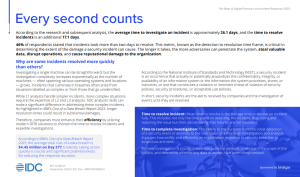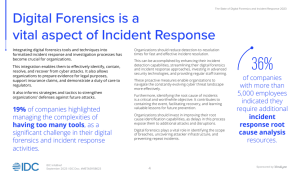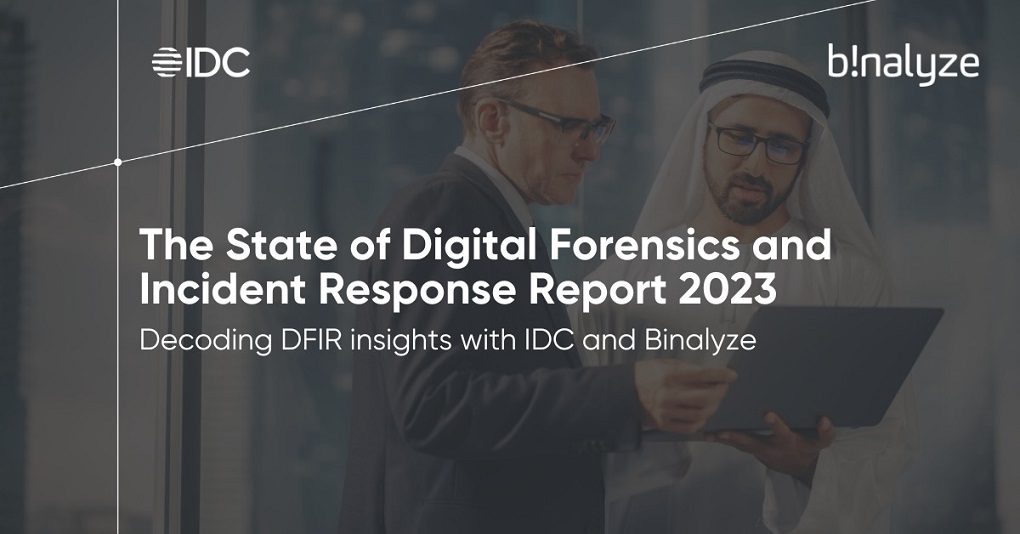With the intricacies of the digital world growing exponentially, the relevance of effective and timely Digital Forensics and Incident Response (DFIR) cannot be overstated.
Executive summary
The interconnected nature of our modern world is leading to a greater risk of various cyber threats, such as data breaches, malware attacks, and unauthorized access. These threats pose significant risks and can result in severe consequences for individuals, organizations, and governments.
As the digital landscape continues to rapidly expand, so does the volume of data, generated by enterprises across on-premises, cloud, and hybrid environments. As security operations centers (SOCs) more commonly use a mixture tools such as endpoint detection and response; security information and event management; and security orchestration, automation, and response – the need for digital forensics and incident response (DFIR) will become ever more important.
1. The importance and challenges of digital evidence in modern investigations:
In an era of proliferating data sources, the role of digital forensic evidence in investigations is becoming increasingly important. However, handling and analyzing this data creates substantial challenges. A pressing need exists for enhanced analytical tools, greater use of AI, and improved collaborative capabilities.
2. DFIR’s pivotal role in cybersecurity:
In a globally interconnected landscape, maintaining stringent cybersecurity protocols is non-negotiable. DFIR is central to this effort – it is the linchpin of identifying, containing, and rectifying security breaches. By taking a proactive cybersecurity stance and harnessing the full power of DFIR, entities can better protect their digital treasures, confidential data, and vital systems against continuously morphing cyberthreats.
3. The need for investigative analysts and the right solutions:
Most companies are adept at swiftly resolving simple incidents. However, the resolution timeline lengthens in the case of complex issues. The pivotal role of experienced SOC analysts becomes evident here, as they have the aptitude to identify and thoroughly investigate these incidents. It is evident that DFIR investments in the Middle East are poised to surge.
4. Background and aim of the study:
This analysis draws on IDC’s Binalyze DFIR Survey, which was conducted among corporate DFIR experts in the Middle East. The selection criteria were stringent, and participants had to be at the helm of cybersecurity functions. Most respondents play a pivotal role in executing or overseeing incident response and digital forensics tasks. The primary objective of this report is to provide actionable insights and analytical perspectives for decision makers.
Recognizing this need for insight, Binalyze, in collaboration with the global market intelligence firm IDC, is excited to publish a compelling new report: “The State of Digital Forensics and Incident Response 2023”.
Based on an extensive survey conducted in June 2023, the study brings into focus the perspectives of over 100 cybersecurity professionals from five Middle Eastern countries.

This diverse respondent pool consists of individuals directly influencing the cybersecurity functions within their organizations, with roles spanning SOC analysts, DFIR professionals, Incident responders, Threat hunters, SOC managers, and Directors.
The key findings of the report are critical for anyone involved in DFIR, from SOC teams to individual analysts and investigators. Report highlights include:
● According to the research and subsequent analysis, the average time to investigate an incident is approximately 26.1 days, and the time to resolve incidents is an additional 17.1 days.
● The importance of reducing “detection-to-resolution” times for efficient incident management.
● The ongoing skills shortage: 81% of respondents identified this as a major challenge.
“Our world thrives on digital connections, but with this connectivity comes vulnerabilities. As the frequency and intensity of cyber threats surge, the importance of DFIR in understanding, mitigating, and learning from these threats is paramount. There is a real and urgent need for forensic visibility at speed and scale. AIR is a game changer here and should be at the center of all SOCs DFIR effort,” says Ahmet Öztoprak, Senior Sales Director of META at Binalyze.
This report serves as both a wake-up call and a guide. By leveraging the insights from the top cybersecurity professionals in the Middle East, ‘The State of Digital Forensics and Incident Response 2023’ aims to provide companies with the knowledge and solutions they need to combat emerging cyber threats effectively and maintain resiliency.

Key takeaways
As the threat landscape expands and the number of threat vectors increases, the importance of digital forensics and incident response continues to grow. Companies must cultivate skilled resources in this field, leverage automation for end-to-end process management, and utilize the right tools for digital forensics at scale.
Resolution vs. Investigation time
On average, security incidents are resolved in 17.1 days; however, comprehensive investigations span a significant 26.1 days. A pressing need remains to streamline and expedite investigations, especially in larger firms. Efficient processes, automation, and AI can be key in accelerating these timelines.
Challenges in investigations
Navigating a maze of varied tools (39%), juggling diverse systems (33%), and collecting evidence from distant locations (50%) make investigations significantly more challenging. This snapshot underscores the urgent need for seamless and intuitive DFIR solutions tailored to an increasingly hybrid and remote world.
Increasing demand
DFIR will clearly remain an important area for investments. A significant 49% of respondents are considering cloud forensics, while others are considering eDiscovery (46%) and root analysis (36%). The increasing demand for resources highlights the growing commitment to these domains.
Integration and automation
Integrating existing security solutions and automating more processes are vital to enhancing cybersecurity teams’ performance. 50% of respondents indicated that automating more processes would positively impact the efficiency and resilience of their organization’s cybersecurity team.
Need for skilled personnel
Efficiency and resilience in terms of cybersecurity hinge on the recruitment of skilled personnel and ongoing training. This means talent acquisition, development, and retention are of key importance.
Don’t miss out on this groundbreaking study. Be among the first to unravel the intricacies of DFIR in the Middle East and adapt your strategies to a rapidly changing digital environment.

